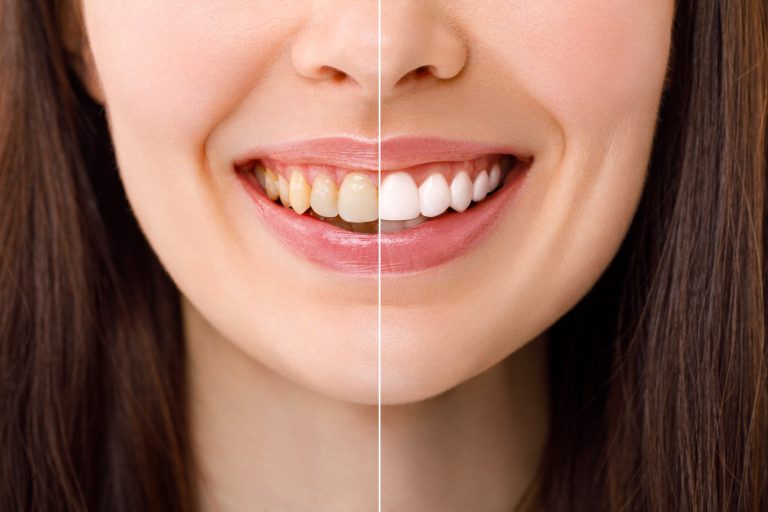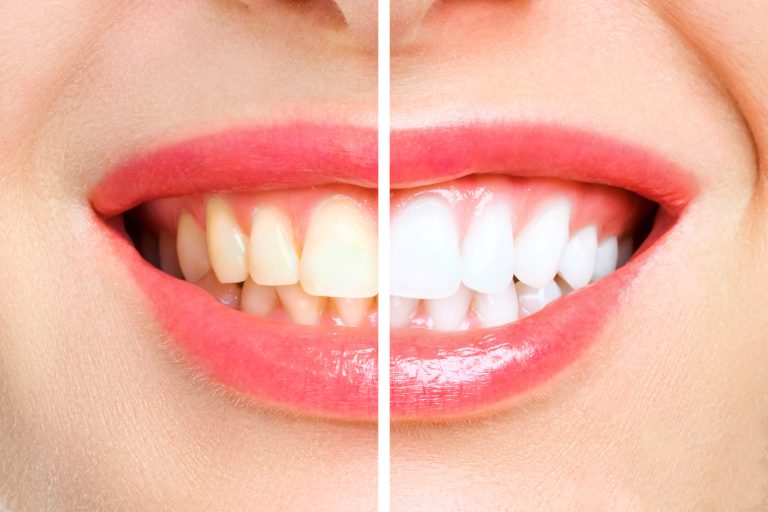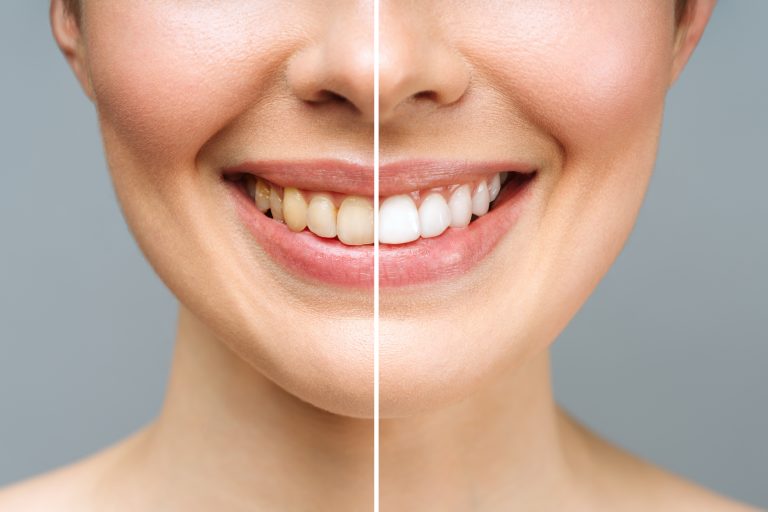


Teeth Whitening: For a Bright Smile
Teeth whitening is a popular and effective cosmetic dental treatment method today. Teeth may become discolored due to factors such as caffeine, smoking, pigmented foods and aging. Teeth whitening reduces this discoloration and makes teeth look whiter and brighter.
What is Teeth Whitening?
Teeth whitening is an aesthetic dentistry procedure applied to restore the natural whiteness of teeth that have changed color over time. Factors such as coffee, tea, smoking, genetic factors, aging and the use of certain medications can cause teeth to lose their whiteness. This procedure helps to achieve a brighter and healthier appearance by lightening the color tone of the teeth by a few tones. Today, teeth whitening procedures are performed by expert dentists in professional clinics or with methods that can be applied at home under the supervision of a dentist.
Having white teeth is an important element that increases a person’s self-confidence as well as providing an aesthetically satisfying appearance. The aesthetic and healthy appearance of the smile allows the individual to communicate more comfortably in social life. Teeth whitening procedures can be applied with various methods and are planned specifically for each person. These methods vary depending on the structure of the teeth and the reasons for their discoloration.
How is Teeth Whitening Applied?
The teeth whitening procedure involves the use of chemical agents to remove the color pigments that accumulate on the surface of the tooth enamel. Whitening substances such as hydrogen peroxide or carbamide peroxide are usually used. These substances penetrate the enamel layer of the tooth, break down the dark pigments and allow the tooth to return to its natural white color. The methods used for teeth whitening can be listed as follows:
Office Type Teeth Whitening
The office type teeth whitening method applied in a clinical environment offers fast and effective results. After your dentist applies whitening gel to your teeth, he activates this gel with UV light or laser to accelerate the color lightening process. Protective barriers are applied to prevent damage to the gums during the procedure, which takes an average of 1 hour. Office type teeth whitening usually provides results in a single session by providing several tones of brightness.
Home Type Teeth Whitening
This method is applied by the patient at home, under the supervision of the dentist. The dentist prepares the plates according to the patient’s mouth size. Again, the whitening gel given by the dentist is applied to the plates and the plates are attached to the teeth. It is recommended that the patient wears this plate for a few hours or at night every day. The treatment period usually varies between 10 and 15 days.
Combined Teeth Whitening
The combined teeth whitening method, in which clinical and home-type whitening methods are used together, provides longer-lasting and permanent results. First, office-type whitening is applied, then the treatment is supported by the plate and gel to be applied by the patient at home.
Single Tooth Whitening
The single tooth whitening technique, applied to a single tooth that has changed color after root canal treatment, is applied by placing whitening gel inside the tooth. The process is repeated several times if necessary.
Is There Any Harm in Teeth Whitening?
Teeth whitening is generally considered a safe aesthetic dentistry procedure. However, in order to ensure the safety of this procedure, it must be performed by professional dentists and with the correct application techniques. It has been proven that teeth whitening performed under the supervision of a physician does not cause permanent damage to the teeth. However, short-term side effects may be observed after the procedure.
After the whitening procedure, some individuals may develop sensitivity to cold or hot foods and drinks. The reason for the sensitivity is that the enamel layer is temporarily affected during the procedure. Fortunately, this usually goes away on its own within 24 to 48 hours. It may be useful to use desensitizing toothpastes to alleviate the sensitivity.
If the whitening gel comes into contact with the gums, mild irritation or redness may occur in the gums. This is usually temporary and can last from a few hours to a few days. In order to prevent irritation, your dentist should apply the gel correctly and oral hygiene should be observed after the procedure.
The water content in the teeth may temporarily decrease during the procedure. Due to dehydration, teeth may appear more dull or opaque than normal after the procedure. However, this condition usually improves in a short time and the teeth regain their natural moisture balance within a few days. Increasing water consumption and paying attention to oral hygiene can help speed up the process.
It is important to follow the dentist’s instructions carefully to minimize side effects. It is also recommended not to use ready-made whitening products without consulting a dentist. Incorrect or uncontrolled applications of such products can lead to permanent tooth damage.
Is the Effect of Teeth Whitening Permanent?
The effect of teeth whitening is not permanent. After whitening, teeth may change color again over time, depending on factors such as the person’s eating habits, smoking and care for dental care. The whiteness obtained after the procedure can last for an average of 6 months to 2 years. This period may vary depending on individual differences and care routine.
In order for the teeth whitening effect to last longer, foods and drinks with high color pigments (coffee, tea, red wine, chocolate, etc.) should be avoided. Such foods can cause stains on the surface of the teeth. If they must be consumed, it will be beneficial to rinse your mouth with water immediately afterwards.
Teeth should be brushed regularly using toothpastes containing fluoride. All surfaces of the teeth should be brushed carefully at least twice a day, in the morning and evening. In this way, it is possible to strengthen tooth enamel and prevent cavities.
The use of cigarettes and other tobacco products should be stopped. Tobacco products can not only stain the teeth, but can also lead to gum disease and oral cancer. Therefore, quitting is important for both oral health and general health.
In addition, regular dentist check-ups should not be skipped. Dentist visits are of critical importance for maintaining dental health. Check-ups every six months allow for early diagnosis and treatment of potential problems. Periodically renewing the whitening process can be effective in preserving the aesthetic appearance of the teeth. For this, check-ups should be done as frequently as your dentist recommends.
What Causes Different Tooth Colors?
Differences in tooth color are a result of genetic, environmental and lifestyle factors. The natural color of teeth can vary from white to yellow. However, some internal and external factors can cause teeth to turn a darker color than normal.
Internal Factors
Some individuals may have darker teeth from birth. Especially antibiotics such as tetracycline used during childhood can cause permanent changes in tooth color. Excessive fluoride exposure can cause white stains on tooth enamel. With aging, the dentin layer becomes more visible as tooth enamel thins over time and teeth appear more yellow. A blow to the tooth can cause the tooth to lose its vitality and turn gray or brown.
External Factors
Coloring products such as tea, coffee, red wine and cigarettes can cause pigment accumulation on the tooth surface. Plaque and tartar accumulation can cause teeth to turn yellow. Food coloring or acidic drinks such as chips can cause discoloration in teeth.
Since each individual’s tooth color can be affected by different factors, regular dental care and teeth whitening procedures when necessary are important.
Professional Teeth Whitening Service
Professional teeth whitening performed in a clinic environment is performed safely and effectively by dentists. First, a special gel is applied to clean the teeth and protect the gums. Then, the whitening gel is applied to the surface of the teeth
e is applied and made effective with the help of a special light or laser. This process usually takes 1-2 hours and is usually performed in a single session.
Advantages of Teeth Whitening
Teeth whitening not only provides an aesthetic smile, but also increases your self-confidence and improves your overall appearance. White and healthy looking teeth give the impression of youth and health. Teeth whitening can also help you feel better and be more comfortable in your social relationships.
After Teeth Whitening Procedure Care
After teeth whitening, you should take care of regular dental care to keep your teeth white and bright. Avoiding habits such as smoking, caffeine consumption, regular brushing and flossing support this process.
Bize Mesaj Gönderin
Randevu Saatleri
Pazartesi – Cuma: 08:00 – 18:00
Pazar günleri ve resmi tatillerde kapalıyız.
İletişim
Yeni Mahallesi İntizam Sokak No:7 Pendik / İstanbul
0216 390 95 80
0505 372 09 26
Hasta Yorumları
Kliniğimizde, sıcak bir karşılama, şeffaf iletişim ve üstün hizmet kalitesiyle, diş sağlığı konusundaki tüm ihtiyaçlarınıza cevap vermeye hazırız.
Kaplamalarımla alakalı gitmiştim kaplamalarımın altında kistler oluşmuştu. İmplant takıldı şuan çok memnunum .Esra hanımdan önce 3 -4 tane dişçiye gittim ama hep problemler çıkardılar kaplamayı takarken dişlerimi kökten kırdılar. En son Esra hanımı önerdiler gittim ve çok memnun kaldım . Eli çok hafif ve işi bilen bir hekim Kanal tedavisi ile dişlerimin tamamını kurtardı. yakınlarıma,aileme tavsiye ettim . Ailemden de gidenler var.

TR
Esra hanıma komşumun tavsiyesi üzerine gittim iyi ki tavsiye etmiş iyi ki gitmişim çok memnunum implant yaptırdım tedavim hala da devam ediyor çok içten bir doktor hastasına güven veriyor ve çok rahatlatıyor ben de herkese tavsiye ederim

TR
Sıkça Sorulan Sorular: “Diş Beyazlatma“
Evet, diş beyazlatma işlemi, uygun koşullar altında ve bir diş hekimi gözetiminde yapıldığında güvenlidir. Profesyonel diş beyazlatma, dişlerinize ve diş etlerinize zarar vermeden etkili sonuçlar sağlar. Evde kullanım için tasarlanmış ürünlerde de diş hekiminizin önerilerine uyduğunuz sürece herhangi bir risk minimaldir.
Diş beyazlatma işleminin etkileri genellikle 6 ay ile 2 yıl arasında değişiklik gösterebilir. Bu süre, kişinin yaşam tarzına, diyetine ve ağız bakım rutinine bağlı olarak farklılık gösterir. Düzenli ağız bakımı ve belirli yiyecek ve içeceklerden kaçınma (örneğin kahve, çay, şarap ve sigara) beyazlığın daha uzun süre korunmasına yardımcı olabilir.
Çoğu insan için diş beyazlatma işlemi sırasında veya sonrasında minimal rahatsızlık yaşanır. Ancak bazı kişilerde geçici diş hassasiyeti oluşabilir. Bu hassasiyet genellikle işlem sonrasında birkaç gün içinde azalır. Diş hekiminiz, hassasiyeti azaltmak için önerilerde bulunabilir veya özel ürünler önerebilir.
Diş beyazlatma çoğu yetişkin için uygundur, ancak bazı durumlar dikkate alınmalıdır. Hamile veya emziren kadınlar, genç çocuklar ve belirli diş ve diş eti hastalıklarına sahip kişiler için diş beyazlatma önerilmeyebilir. Ayrıca, önceden yerleştirilmiş kronlar, kaplamalar veya dolgular renk değiştirmez, bu nedenle tedavi öncesi tam bir değerlendirme önemlidir. Diş beyazlatma hakkında en doğru bilgiyi ve öneriyi almak için diş hekiminizle görüşmelisiniz.
